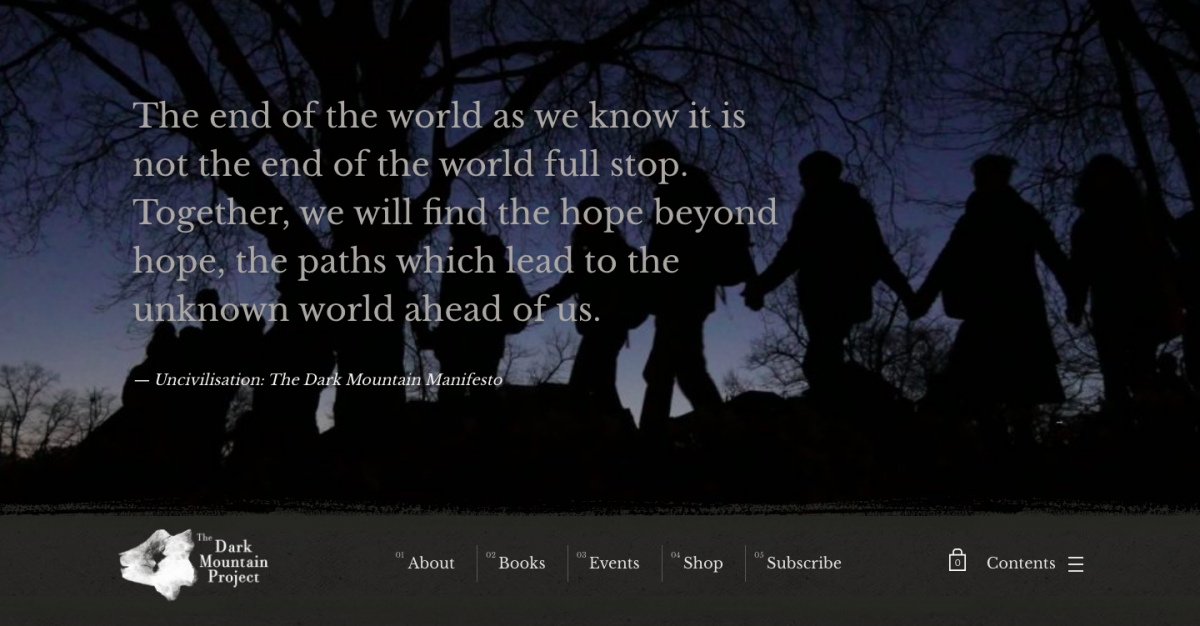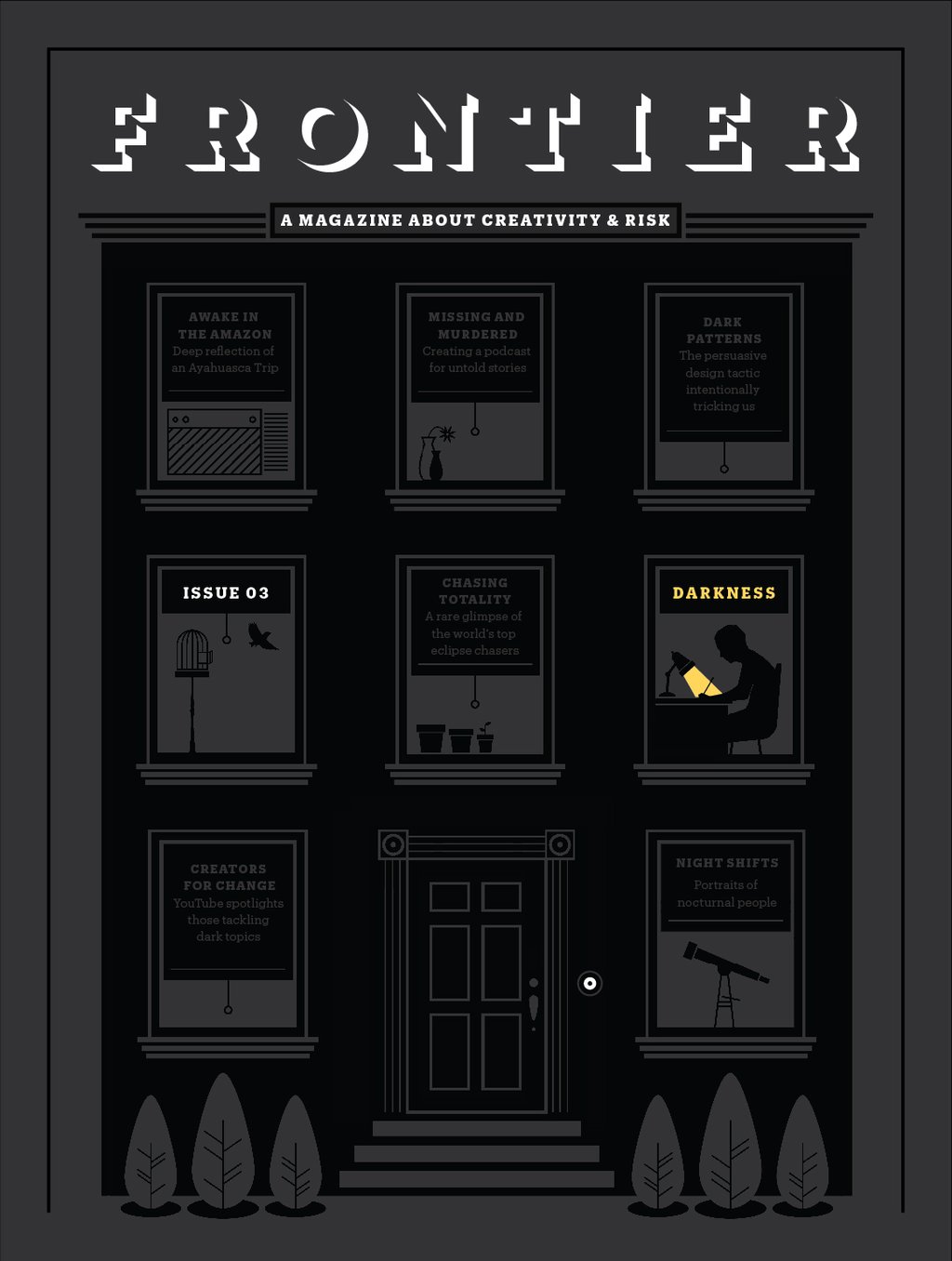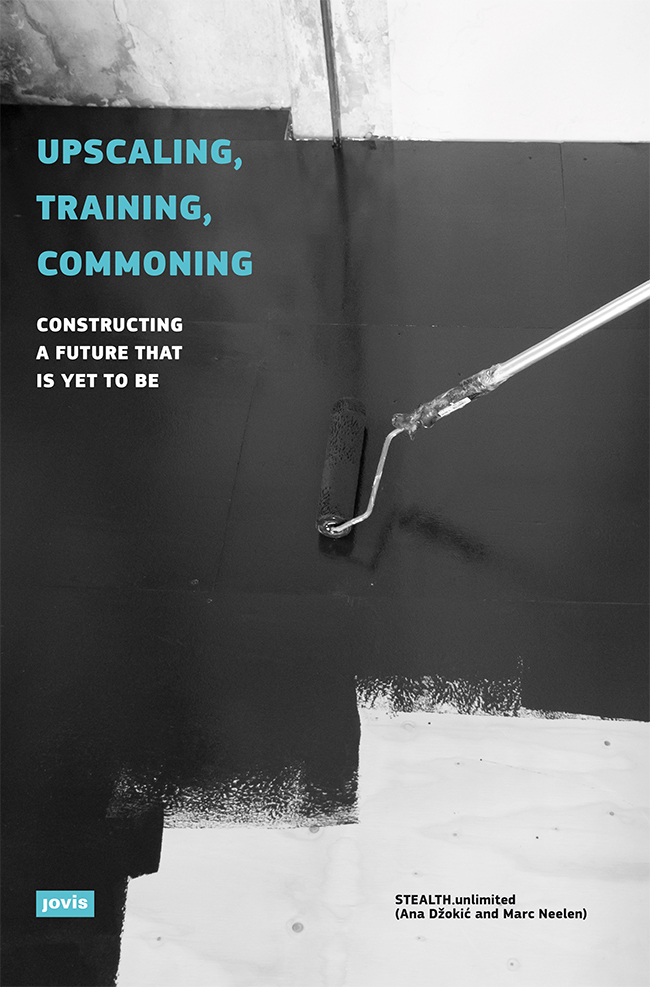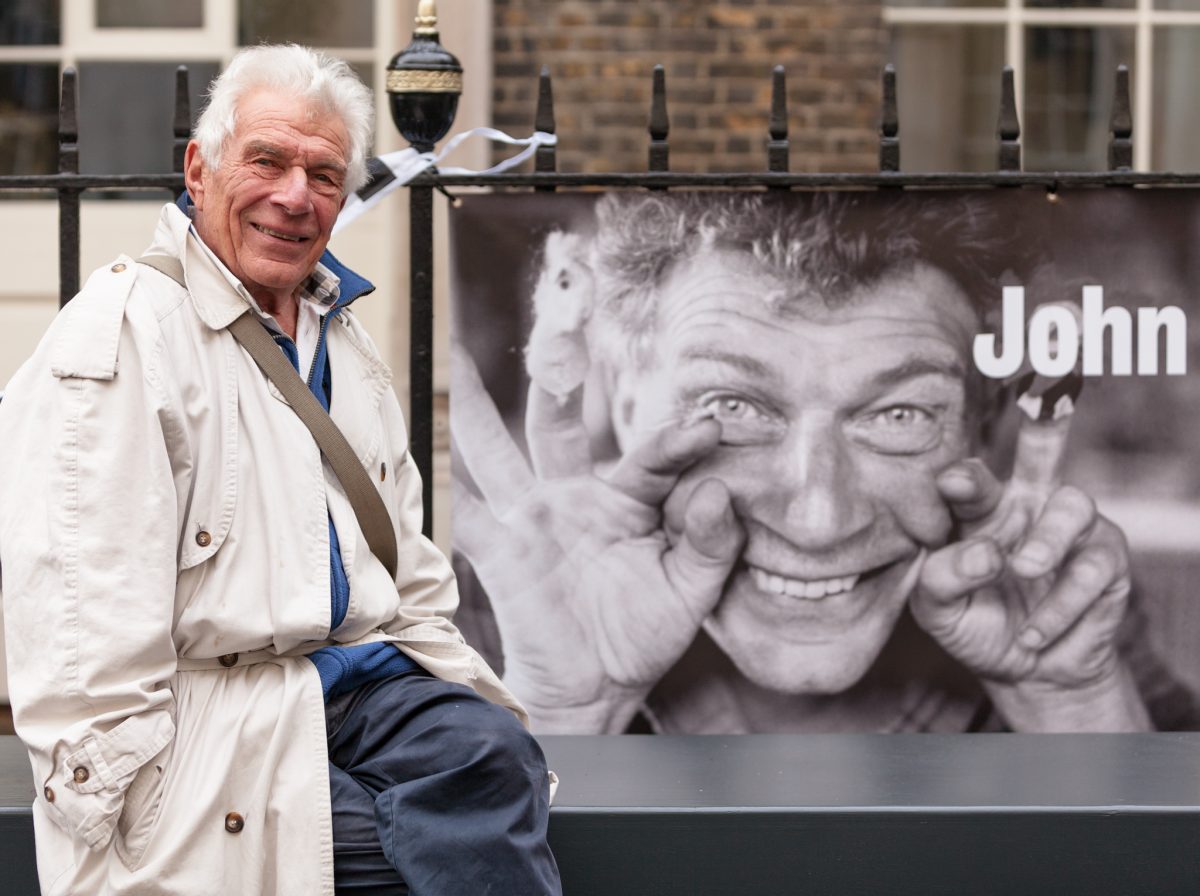An hour’s drive northwest from here, you take a turning off the two-lane highway, near the bottom of a steep hill. After that, you’re on an unpaved road, heading into the woods. At first, there are red wooden houses dotted to either side, but then the scattered township thins out and for the last couple of miles, there’s just you and the trees, a glimpse of lake somewhere off to the left, and this single-track road.
I’m doing my best, but it’s hard to reproduce the unexpectedness of what comes next. When I bring people here, however much I’ve told them, there’s always an audible expression of amazement as we round the last corner and this huge white Bauhaus structure comes inexplicably into view. It gets better, because as we park and climb out, the newcomers peer through the glass in disbelief, starting to make out a building within a building: the old red wooden schoolhouse, two storeys high, which served as the first home for the gang of theatremakers who dreamed this madness into being, still stands where it always did, inside one wing of the new structure.
Back in November, the day after I turned forty, this is where we came. Eight grownups and two small kids, cars slithering down the icy road: a little gang of friends and collaborators who had taken up my invitation to spend a weekend at the impossible theatre in the woods, thinking about the years ahead and what we might do together.
The idea didn’t arrive while we were out there – they keep their own time, ideas like this, and mostly they show up sometime after you let go of your expectations, really let them go, with no promise that anything will come along to take their place. You have to give up. And then, if you’re lucky, something shows up, and it doesn’t look like what you were expecting, but maybe it is the thing you didn’t know you were looking for.
So yeah, something showed up. In the days afterwards, nurtured in conversations around our kitchen table, an idea took shape. And here it is – it’s time to start a school.
This year, Anna and I are starting a school together. It’s a school called HOME, a school for culturemakers. Over the past few months, we’ve been figuring out how to talk about it, starting to tackle the practicalities – and today it’s time to share where we’ve got to and make an invitation.
Here’s one way that we talk about it:
HOME is a school where we study the mess the world is in, not as a set of discrete problems to be solved, but as a tangled and humbling predicament.
We follow the roots of this predicament deep into history, uncovering the buried assumptions which have shaped our ways of seeing and being in the world, catching sight of the possibilities those assumptions hid from view.
We learn from artists, philosophers, community builders, improvisors, historians and poets. Looking for a term to bridge these worlds, we call ourselves a school for culturemakers. We cultivate the art of invitation, hospitality and friendship, finding here the seeds of other ways of being human together.
It starts quite simply with a one-week course this summer. The course will run from 4-8 June in the village of Ängelsberg, a couple of hours train ride west of Stockholm. I’ll be teaching alongside my friend Andrew Taggart, a practical philosopher who weaves webs of conversation, enquiring into the gaps within our present ways of life. We’re calling the course Finding Our Way Home and it starts with a question: ‘What if the culture you grew up in was broken in ways that you didn’t even have words for?’
We’ve already taken a few bookings before we got as far as launching a website, but today the site is launched and open for enquiries. You can read the rest of the invitation that we’ve made – and, given that the last residential course I taught sold out with two months to go, should you find that the invitation speaks to you, then I’d encourage you to send us an enquiry without delay.
Meanwhile, in the spirit of these letters, I want to head a little deeper into the woods, to think aloud about what it means to start a school, where this has come from and where it might be heading – and, for those with long memories, to say a word or two about that time when I was going to start a university.
There are books that matter to you immensely at a certain moment in your life and a few years later you can hardly remember why – and then there are pieces of writing, often no more than a few lines, that you know you’d carry with you to the ends of the world. One of mine is a passage from The Cultivation of Conspiracy, an address given by Ivan Illich in Bremen in 1998. He is looking back on the places of convivial learning that he had created with his friends over the previous forty years – from a ‘thinkery’ in a one-room shack on a Puerto Rican hillside, to the Centre for Intercultural Documentation at Cuernavaca, Mexico, to the hospitable household at Kreftingstraße, where on Fridays after Illich’s lectures the spaghetti bowl would feed two dozen guests around the table, with sometimes more spilling out to sit on the Mexican rugs in the next room. In all of these places, he says, they have sought to foster a particular atmosphere:
Learned and leisurely hospitality is the only antidote to the stance of deadly cleverness that is acquired in the professional pursuit of objectively secured knowledge. I remain certain that the quest for truth cannot thrive outside the nourishment of mutual trust flowering into a commitment to friendship.
I’ve carried those lines for years, like a navigational instrument, looking for the places which have that atmosphere, seeking to cultivate it in the spaces where I’ve worked. So when I think about what it means to start a school, it doesn’t start with a course or a curriculum or a building, but with the way of being together that Illich is talking about.
There are people whose work you discover at the right moment. The year I discovered Illich, I was twenty-five and I’d just walked out on what looked like the beginnings of a successful career at the BBC. I’ve heard stories like this often enough now to know the pattern: sometimes you have to give up, to turn down the offer no sensible person would refuse, to walk away without any explanations that will satisfy your friends’ parents or your parents’ friends, because that’s the price of entry to a different kind of life. At the time, all I knew was that I’d exchanged a staff job in the newsroom for temping in warehouses and call centres, a new sense of freedom, and the realisation that the university careers service didn’t have any lives my shape. If I wasn’t going to contort myself into one of the careers on offer, I would have to make a life of my own.
Books were my friends that year and I read with a focus that surpassed anything I’d had as a student at Oxford. I was reading for my life and the writers I discovered became my companions.
Four years down the road, I would travel to Cuernavaca, to a gathering of Illich’s friends and collaborators, where the atmosphere he spoke about in Bremen still lingered in the late night conversations. I remember sharing a taxi through the city with one of them, Carl Mitcham, and telling him that I was working on an internet startup inspired by Deschooling Society. At this, he burst out laughing. ‘I remember Ivan telling me, “People are saying I invented this internet!” The thought was enough to make him throw up his hands in horror!’
School of Everything – the startup I co-founded in 2006 – took its inspiration from Illich and the ‘free universities’ of the late 1960s, but the path it went down was summed up by Cory Doctorow, who wrote that we were building ‘the eBay for learning’. What’s strange is that we knew better. The five of us who started it had met in a room where learning was understood as a matter of relations, not transactions. It was one of a series of such rooms, spaces with names like the University of Openness, the Temporary School of Thought and the Really Free School. On a good day, they too had that atmosphere, and they were spaces in which people seemed to come alive.
Out of those experiences came a desire for something more-than-temporary. And I had been learning the art of talking projects into reality: after School of Everything, I started Spacemakers, and the same year, Paul and I launched Dark Mountain. I’d grasped something about how to tell a big story and invite people to step inside that story and make it real together. I was just past thirty, and making up for lost time, running off the raw red energy that comes with discovering your own abilities. I didn’t know much yet about limits, or about failure.
So in the early spring of 2011, I threw out my biggest story yet. First on the internet, and then in talks at places like the Royal Society of Arts and TEDx London, I asked for help to start a new kind of university. I’d pulled off enough wild schemes by then that people gave me a hearing, and all kinds of conversations and connections came about as a result – but as summer turned to autumn, the plan unravelled, while the pace at which I’d been living finally caught up with me. Within a year, I would leave London.
It was a humbling time. Soon after I arrived in Sweden, I remember my old friend Charlie Davies – he was the one who had brought together the temporary school where the founders of School of Everything first met – handing me a small coin, looking me in the eye, and saying, ‘I give you failure.’ There are journeys for which no other currency is taken.
The luckiest stroke I ever had was that, just as my London life fell to pieces, I met someone who could see past the mess I was in and who chose to make a life with me. Anna and I had been travelling different routes, but steering by the same stars. In her case, the route had led from connecting cultural foundations around Europe, to setting up children’s libraries in the Middle East and supporting women’s organisations in Israel and Palestine. At the heart of it was a commitment to conviviality: her tiny flat in Stockholm was dominated by a table large enough to seat fourteen; the wall between the kitchen and the bedroom had been taken down to make room for it.
As I said goodbye to London, having given up on the idea of starting some kind of university, I remember an unfamiliar sensation of patience. Whatever mattered about that idea would come back in a different form when the time was right.
If the time seems right now, that’s firstly because I’m not doing it alone. Over the past six years, Anna and I have made a home together that is a place of friendship, hospitality and intercultural encounter. We knew from the start that we wanted to make a wider invitation and create a shared foundation for our work. In the idea of a school called HOME, that intention has found its form.
Then it’s because I have things to teach. Looking back, those earlier free universities and temporary schools were a source of fellowship, a meeting point for an invisible college in which I found my contemporaries – and bringing people together like that still feels vital. But in the past couple of years, I’ve found that the teaching I do is moving to the heart of my work. Walking into a room, sharing stories and ways of thinking that I’ve found helpful, letting the questions that follow lead us deeper. (As I write this, I remember a recent visit to the Kaospilots school in Aarhus, Denmark: for a month afterwards, most days my phone would ping with mails and messages from students who had been in that room, still resonating with the ideas we’d talked about.) So I want to create the conditions where I can do that well.
Finally, the time seems right because I’ve come to see another way of making projects happen. Sometimes telling the biggest story you can and getting hundreds or thousands of people to step inside it is the way to go – but the best work often happens more quietly. I’m prouder of the West Norwood Feast, the community-owned streetmarket that Spacemakers helped start in south London, than the project that we did at Brixton Village, which is the one that got all the attention.
For several years now, I’ve been teaching residential courses at places like Schumacher College, so the first step in starting this school is to take that kind of course and organise it on our own terms.
Beyond that, Anna and I are inspired by the example of small schools that offer longer programmes – places like the Westcountry School of Myth and Story, run by our friend Martin Shaw, or Stephen Jenkinson’s School of Orphan Wisdom. So before long, we want to create something along those lines, making an invitation to be part of a learning community that comes together several times a year.
In the longer-term, our intention is to find a permanent location, a place we can call home in all senses of the word, with the further possibilities that would offer. A few years from now, I’d love to be holding a yearly summer school, a little like what I’ve heard tell of the summers in Cuernavaca, half a century ago.
In the meantime, we’ve found a beautiful setting in which to get started, working with a family-run hostel in Ängelsberg. It’s a village of 150 people with its own railway station, there’s a lakeside sauna and all the other things you’d want in Sweden with midsummer around the corner. And going by the first few people who are on board, it will be quite a special gang that gathers there this June.
There was a time when I was launching projects left, right and centre – throwing out ideas, some of which took on a life of their own, while others left no trace. Writing this, I realise that it’s been a while since I launched something new, and rarely have I put as much of my heart into a project as with this little idea for a school.
It won’t be a school of everything, and it doesn’t promise to reinvent the university. We’re not out to build a grand highway to the future. This is a little road heading into the woods. Maybe you will join us on that road. I hope so.
Published as Issue 16 of Crossed Lines, my occasional email newsletter, to mark the launch of a school called HOME.





